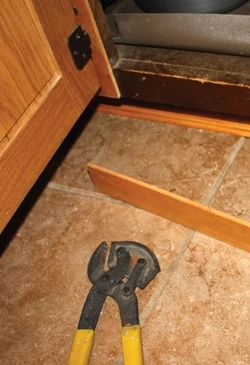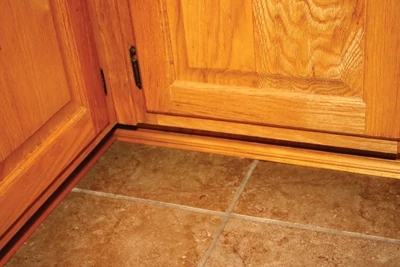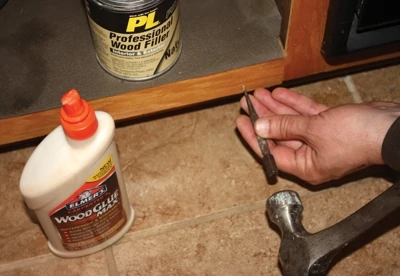By Matt Weber
Cabinet veneer gives the appearance of solid hardwood at a fraction of the cost.
Cabinets aren’t considered an option for most American households—they’re seen as a requirement. The more stuff you have, the more storage you need, and it’s nice to have doors that conceal the clutter from view. Cabinets come in many forms and styles, ranging in material from medium-density fiberboard (MDF) to solid hardwoods. Cherry, oak and maple are popular wood species for cabinet construction, offering rich woodgrain appearance and long-term durability. The draw-back is the cost, as the material and construction of custom hardwood cabinetry can easily run into the thousands. One way to achieve the look of hardwood cabinets at a fraction of the expense is to use plywood veneer over an old cabinet case.
As you can see in the photos, the L-shaped run of cabinets in this kitchen is a hybrid of an old case of MDF cabinets combined with a newly built case of solid hardwoods. The original case houses the oven with cabinets on each side, comprising the short arm of the “L.” Later in the life of the home, the cabinetry was expanded to add overhead units as well as a longer floor run along the adjacent wall that intersects the original cabinets—the long arm of the “L.”
The homeowner ordered the new cabinets to be face-framed with solid ¾-in. oak, complete with solid oak doors and oak ply for the case. However, the old cabinets were made of MDF with cheap wood face-frames, which would not match the stained oak. One option would be to remove the old cabinets and replace them with the new oak design.
However, to avoid that expense, the carpenter suggested using ¼-in. oak veneer over the existing MDF case. The veneer provides the genuine oak woodgrain to blend with the adjoining solid cabinets, and the finish is stained to match, concealing the difference in construction. By using the existing case, the homeowner avoided the cost of labor and material to replace it and by using ¼-in. veneer over the existing face-frames rather than solid oak, a lot of money was saved on raw material. (The doors, however, were replaced with solid oak frame-and-panels to match the new carpentry.)
Ultimately, the two intersecting cabinet cases appeared to match exactly.
Easy Application
Adding cabinet veneer is a fairly straightforward process of cutting pieces to fit over the existing cabinet frame. You will need a table saw to rip the pieces to width and length. Keep the look convincing by measuring the pieces to fit exactly over the existing framing members, maintaining the appearance of traditional construction (i.e., run the “stiles” from top to bottom, with the “rails” butted between them, just like the case is built).

Dry-fit the veneer pieces to ensure a tight fit. You want the illusion of solid-frame construction, so accuracy is critical. If necessary, temporarily tape the pieces while you test-fit them. Once satisfied with your placement, apply the veener pieces to the cabinet face with quality wood glue and finish nails. Apply glue to the mating edges of the veneer pieces.
I recommend pre-drilling the nail holes to prevent any splitting in the hardwood face. Use a nail set to sink the nail heads just below the wood surface. The nails will hold the pieces secure while the glue dries, but it’s the glue that will give the pieces their holding power. Use a stainable wood putty to fill the nail holes, sand smooth, then stain the wood to match.

If veneering the broad side of a cabinet case, the corner seam between the side panel and face-frame veneer can be concealed with a piece of small-profile corner moulding.

The end result of installing veneer over an existing case can give old cabinets a brand new breath of life while saving big bucks compared to the cost of new construction.



